There have been many natural disasters since the 2004 Indian Ocean tsunami, but none have exceeded it in the combination of scale and scope of its destructive impacts.
The scale of devastation for coastal communities in the Indonesian province of Aceh was unprecedented, and the shock was felt globally. The tsunami waves resulted in death and destruction on unsuspecting communities as far away from the earthquake epicentre as northeast Sri Lanka and southern India.
The world responded with remarkable concern and compassion for the tsunami victims. But the aid and the involvement in relief and recovery efforts by so many agencies caused major headaches for national or provincial governments who were caught unprepared. Sri Lanka, in particular, had no inkling that it was vulnerable to a disaster of this kind and scale and so the relief and recovery effort became something of an experiment.
Aid relief: careful versus quick
The lack of co-ordination at local and regional levels and the desire of international aid agencies to have quick, reportable, outcomes led to considerable wastage of the delivered aid. One lesson of the tsunami disaster in Sri Lanka is that there should be an emphasis on using aid money carefully and patiently rather than too hastily.
Also, the mantra of “build back better” meant that well-meaning people and agencies commonly made decisions that left people in worse situations than before in terms of access to livelihoods and the maintaining social support networks. Relocation, to reduce future disaster vulnerabilities, was often handled without adequate consultation and attention given to the complex, long-term, social needs of the disaster victims.
I was the head researcher on a four-year study for AusAID on what could be learnt from the efforts to rebuild tsunami-affected local communities in Sri Lanka and southern India. This study found that the immediate relief effort was better than had been expected. However, authorities made mistakes when people were put into hastily constructed temporary shelters on the assumption that they would soon be moved into new permanent housing.
As a result, the planning and construction of new permanent settlements was often rushed and inadequate attention was paid to their location, layout, and even the question of co-location of people who could either reconstitute or establish strong social networks.
A recent study, headed by Professor Siri Hettige of the University of Colombo, found that some settlements built to house tsunami victims in Sri Lanka have now been abandoned. A significant number of survey respondents also reported that social cohesion in the new communities was worse than what they had known before the tsunami.
The special needs of women were also not addressed during the different stages of relief and recovery. Hettige’s survey found that more women than men felt that they had not received the assistance they needed.
Our earlier study found that it is important to distinguish between the immediate relief effort, when speed and efficiency is paramount, and the subsequent stages of intermediate and long-term recovery. For the intermediate stage, disaster victims need to be housed in adequate temporary accommodation so that the planning and construction of new permanent settlements is not rushed.
Local knowledge is critical for the planning and construction of temporary accommodation where people might be housed for years rather than months. It becomes even more important for the physical and social planning for new permanent settlements.
Unfortunately, disaster relief and recovery work tends to be dominated by people who have good logistical and technical skills but they may have little experience or competency in regard to social planning or community engagement. The work continues to be rather gender-blind.
Next steps
International research on disaster management is full of rhetorical commitments to community engagement and participation in relief and recovery work. However, this work requires extreme patience and an aptitude that is not commonly found among those who are attracted to disaster management work.
I have argued recently that the United Nations should set up a new agency or sub-agency charged with responsibility to collate examples of good practice in regard to community engagement in disaster preparation, relief and recovery. This can then be used to train people for this kind of work. Only a community development approach can truly result in “build back better”.
International aid agencies commonly espouse a commitment to community development. However, they commonly pursue a set timeframe for engagement and withdrawal without having proper transition arrangements in place to ensure that any efforts made to build community infrastructure can be continued after they withdraw.
We now have a growing body of examples of good and bad practice in regard to the rebuilding of disaster-affected communities. However, the rhetoric of “build back better” continues to ignore this important work. The onset of global climate change suggests that more local communities will be in the path of unexpected disasters that can divide communities and leave many people worse off than they were before.
It is time to think much more carefully about what it takes to work with affected people and communities to ensure that their long-term social needs can be addressed.

